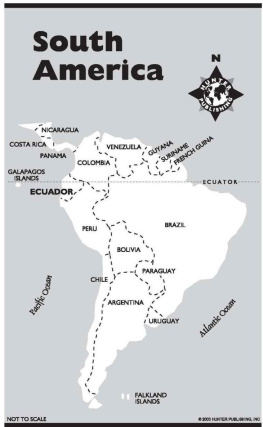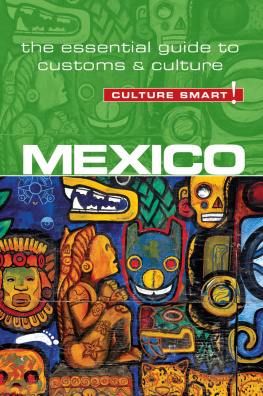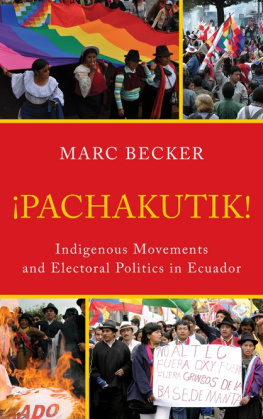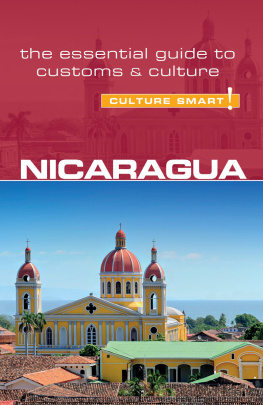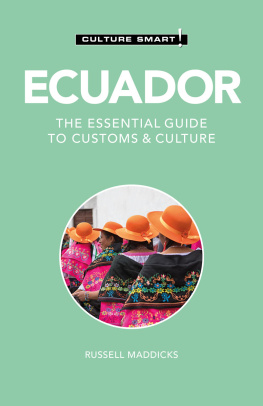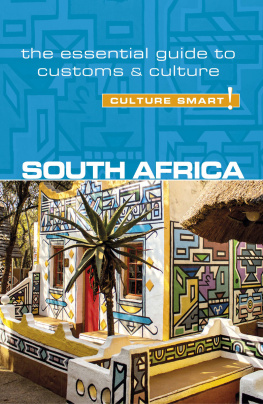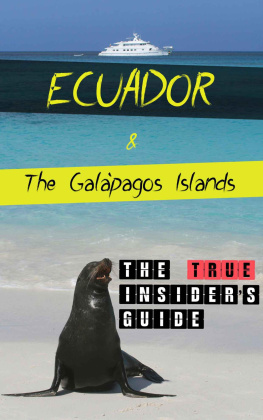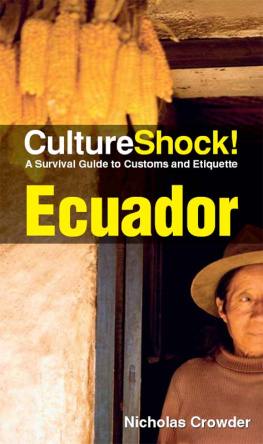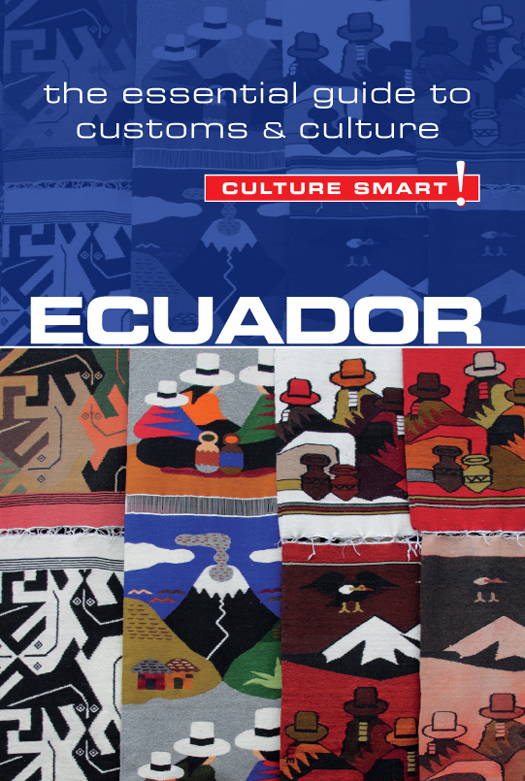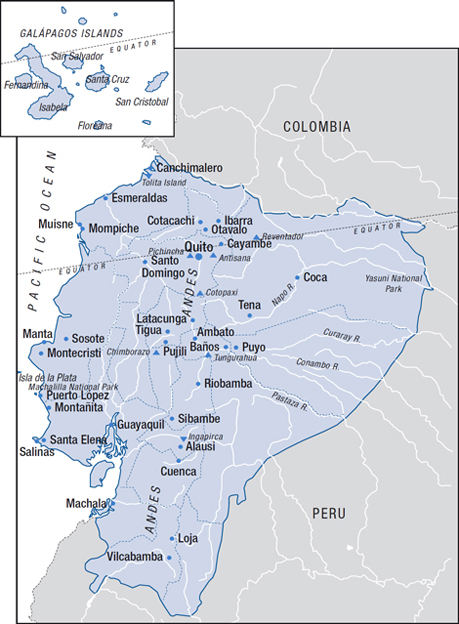Copyright 2015 Kuperard
All rights reserved. No part of this publication may be reprinted or reproduced, stored in a retrieval system, or transmitted in any form or by any means without prior permission in writing from the publishers.
Culture Smart! is a registered trademark of Bravo Ltd.
ISBN 978 1 85733 683 2
This book is also available as an e-book: eISBN 978-1-85733-684-9
British Library Cataloguing in Publication Data
First published in Great Britain
by Kuperard, an imprint of Bravo Ltd
59 Hutton Grove, London N12 8DS
Tel: +44 (0) 20 8446 2440 Fax: +44 (0) 20 8446 2441
www.culturesmart.co.uk
Inquiries:
Distributed in the United States and Canada
by Random House Distribution Services
1745 Broadway, New York, NY 10019
Tel: +1 (212) 572-2844 Fax: +1 (212) 572-4961
Inquiries:
Series Editor Geoffrey Chesler
Design Bobby Birchall
Cover image: Hand-woven rugs on display in the highland town of Otavalo. Dreamstime
Image on iStock.
Images on the following pages reproduced under Creative Commons Attribution-Share Alike 3.0 Unported license: Jean Vera.
Reproduced under Creative Commons Attribution-Share Alike 2.0 Generic license: .
Free Art License: (1) Dr. Roberto Lev Castillo (Rolecas).- El Telgrafo, Ag. 10/84. (2) Julio Tobar Donoso.- La Iglesia, Modeladora de la Nacionalidad, p. 265.
v3.1
About the Author
RUSSELL MADDICKS is a BBC-trained writer, translator, and journalist. A graduate in Economic and Social History from the University of Hull, England, he has spent the last twenty years traveling, living, and working in South and Central America, most recently as a Latin American Regional Specialist for BBC Monitoring. A fluent Spanish speaker, he has made many extended trips to Ecuador, one of his favorite South American destinations, where he has explored the length and breadth of the country both for work and for pleasure. He is also the author of Culture Smart! Venezuela (2012) and the Bradt Guide to Venezuela (2011). You can follow him on Twitter @EcuaTravelGuide.
The Culture Smart! series is continuing to expand. For further information and latest titles visit
www.culturesmart.co.uk
The publishers would like to thank CultureSmart!Consulting for its help in researching and developing the concept for this series.
CultureSmart!Consulting creates tailor-made seminars and consultancy programs to meet a wide range of corporate, public-sector, and individual needs. Whether delivering courses on multicultural team building in the USA, preparing Chinese engineers for a posting in Europe, training call-center staff in India, or raising the awareness of police forces to the needs of diverse ethnic communities, it provides essential, practical, and powerful skills worldwide to an increasingly international workforce.
For details, visit www.culturesmartconsulting.com
CultureSmart!Consulting and CultureSmart! guides have both contributed to and featured regularly in the weekly travel program Fast Track on BBC World TV.
contents
Map of Ecuador
introduction
Ecuador may be the fourth-smallest country in South America, but this compact Andean nation punches above its weight in terms of diversity, from its world-class wildlife and bird-watching opportunities to a geographical landscape so varied that it has been described as a microcosm of every micro-climate found in South America.
Squeezed between Colombia in the north and Peru in the south, Ecuador is named for its location on the Equator. It has some of the highest and most active volcanoes in the world; steamy Amazon jungles in the east; a Pacific coast dotted with fishing villages and beach resorts; and, out to sea, the jewel in the countrys crownthe fabled Galpagos Islands, named after giant tortoises that can live for more than 150 years, and where the young Charles Darwin first had the seed of an idea that germinated into the Theory of Natural Selection and Evolution. All this diversity makes Ecuador a magnet for tourists, mountain trekkers, volunteers, and increasing numbers of US retirees looking for a warm, culturally interesting, economical, and safe place to spend their retirement dollars.
Ecuador has a multiethnic population that reflects a unique blend of cultures, from traditionally dressed mountain peoples whose ancestors inhabited their highland villages before the arrival of the Incas to the AfroEcuadorians of Esmeraldas and the Chota Valley and the tribal peoples of the Amazonian rain forest. Ecuadorians are proud, friendly, hospitable, and hardworking, but to understand the culture in any depth you need to know the complex historical divisions between the highlands and the coast, and the rigid class and racial discrimination that has dominated the countrys history.
Now the country is booming, due in great part to the policies of President Rafael Correa, first elected in 2006, with high oil prices benefiting this OPEC nation, and investment in tourism seeing visitor numbers sharply rising. Determined to forge ahead with his Citizens Revolution, Correa has brought political stability to a nation that had seen seven presidents come and go in the turbulent years between 1996 and 2006. A US-educated economist who follows a similar line to Venezuelas Hugo Chavez and Bolivias Evo Morales, Correa has funded a massive infrastructure program by defaulting on the nations debt, renegotiating oil contracts, making the tax system work, and turning to China for loans.
Fixing roads, building schools, and extending social security protection and poverty-reduction programs have endeared the president to the poorest in Ecuadorian society. His attacks on bankers, oligarchs, and rich media owners have infuriated the moneyed elite, who portray him as a brash populist who is rude and dismissive of his critics and interested only in remaining in power.
Culture Smart! Ecuador takes you beyond the usual descriptions of where to go and digs deeply into the heart of this multilayered, multiethnic nation to provide you with an insiders view of the people, the history, the food, the culture, and an understanding of how Ecuadorians do business, make friends, and meet members of the opposite sex.
Key Facts
| Official Name | Repblica de Ecuador |
| Capital City | Quito | Pop. 2.239m Altitude 9,350 ft (2,850 m) |
| Main Cities | Guayaquil (pop. 2.35m); Cuenca (330,000); Ambato (329,850); Santo Domingo (322,00) |
| Area | 99,706 sq. miles (258,238 sq. km) | Ninth-largest/fourth-smallest country in South America |
| Population | 15,439,429 (2013 estimate) |
| Ethnic Makeup | 71.9% Mestizo (mixed race); 7.4% Montubio; 7.2% Afro-Ecuadorian; 7% Indigenous; 6.1% White (2010 Census) |
| Geography | Straddles the Equator in NW South America. Borders Colombia in the north, Peru in the south and east; long Pacific coast on the west |


